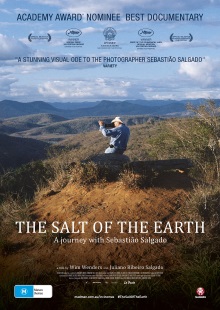
I’ve written about films by director Wim Wenders before in this blog but this one is a documentary. Looking through his filmography, it’s apparent that he has always been making documentaries in parallel with his feature films throughout his career and that they are all, without exception, about fellow creative types: directors, musicians, even a fashion designer. This one is about Sebastião Salgado, a Brazilian photographer of some renown. Salgado’s own son, Juliano Ribeiro Salgado, is named as a co-director for this documentary.
Though it opens with one of Salgado’s most famous series of photographs, of the Serra Pelada Gold Mine in Brazil, this documentary is for the most part a straightforward account of Salgado’s life and his evolution as a photographer. Though a poor student, he eventually became an economist and traveled to Africa for the World Bank. He soon discovered though that instead of being a pencil-pusher, he preferred to be a professional photographer. Unlike so many other dreamers, whether through hard work or sheer talent as this documentary is silent on this fact, he succeeded and with the help of his wife, would eventually travel to the most exotic places around the world to take photos. The documentary traces his path as the focus of his photography work changes over time from the indigenous peoples of far flung corners of the globe to the lowest depths of human misery and finally to a natural world in which modern humans are largely absent.
Looking at the images, there is no doubt that the quality of Salgado’s work is absolutely flabbergasting. The level of detail he can bring out, whether in the vistas of untold thousands of workers in the gold mine or the tent cities of refugees fleeing war leaves you feeling like you can never see everything there is to be seen in each of the photographs. When he takes portraits of people, the intensity of the personality and the depths of the look in their eyes just blows you away. Shockingly, his photographs are equally good when he passes to the phase of taking photos of animals instead of people. As the commentary states, his photo of the face of an ancient giant turtle looks exactly like that of a wise old man who has lived an untold number of years and has an endless number of stories to tell. Wenders clearly has no intention of being outshone by Salgado and tries his best to get great shots as well. One of my favorite moments is when the team is waiting in a shack for a polar bear to get into the right position and Salgado dozes off while outside the bear lays down on the ground. As a feast for the eyes, The Salt of the Earth is an invaluable prize.
As a documentary however, I’m not sure how much value it has beyond being just a showcase vehicle for Salgado’s photographs. The photos themselves are clearly the heart of the film so it sometimes feels like the documentary is little more than a slideshow of his best photos with a commentary track added on top. I’m not even sure that the commentary is all that necessary. Some of Salgado’s anecdotes are entertaining to be sure but he does tend to repetitive and beyond a certain point they simply don’t add much. In my opinion, his best photographs speak for themselves and nothing except for a place and a date are needed. To add anything else actually seems to diminish the expressive power of the image itself.
I also find the details of Salgado’s personal life to be uninteresting and irrelevant. We don’t need to know that one of his son’s has Down’s Syndrome and how the family overcame it for example, especially when it has no bearing whatsoever with his work. It strikes me that having become a fan of Salgado’s work, Wenders became fascinated by the man and made this film because he wanted to know more about the person. Yet he finds it impossible to say anything at all bad about the photographer, to the extent of having his son excuse his frequent absences from his family for his lengthy travels, that this becomes nothing more than a hagiography. The things that Salgado says, about human suffering, about the environment, are the things that we expect someone in his position to say. There’s nothing insightful, nothing novel, nothing that challenges anything. He doesn’t even go into such details as the logistics of his many voyages, or his favorite photography equipment, or how he got the funding for the reforestation project in Brazil, which would have made it a much more informative documentary.
Finally, there’s the moral issue of Salgado’s many close encounters with human suffering, an issue on which subject this film is silent. The photographer speaks at length about the immense misery that he has witnessed and how soul-killing it is, yet obviously he managed to get into these awful places and safely get out again. Did he not feel tempted to place his camera aside and physically help out on occasion? Did he share the food supplies that he must obviously have had with the many victims of famine? I don’t expect this documentary to have good answers to these difficult questions but to not raise the issue at all is simply absurd. This is why as fantastic as the images captured here are, I have to look askance at this documentary. Salgado’s photographs may be great works of art but this film most certainly is not.